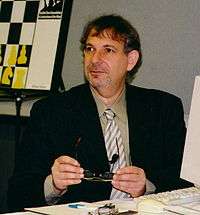Jeremy Silman

Jeremy Silman (born August 28, 1954) is an American International Master of chess. He has won the US Open, the American Open, and the National Open, and was the coach of the US junior national chess team.
Silman has authored over 35 books, mostly on chess but also on casino gambling, and has written articles for chess magazines such as Chess Life and New in Chess.[1] He has also authored many chess mentoring puzzles on the chess.com website.
Silman is the professor in a video chess course produced by The Teaching Company as part of its Great Courses series.
Silman served as a chess consultant on the 2001 Harry Potter film Harry Potter and the Philosopher's Stone,[2] Monk, and Malcolm in the Middle.
Strategy of Imbalances
In his books, Silman evaluates positions according to the "imbalances", or differences, which exist in every position, and advocates that players plan their play according to these. A good plan according to Silman is one which highlights the positive imbalances in the position. The imbalances are, in rough descending order of importance according to Dana Mackenzie:[3]
- superior minor piece, which refers to the relative strength of the knights and bishops;
- pawn structure;
- spatial control;
- material; in his Chess Life series The Art of Planning, Silman called this the most important imbalance because it affected every phase of the game;[4]
- control of open files, diagonals, and squares;
- development;
- initiative; Silman notes that this (along with superior development) is a dynamic imbalance that must be used quickly if the advantage is not to fade away.
Silman's thinking technique
Silman proposes in How to Reassess Your Chess a five-fold procedure that he recommends players to use. This procedure is to be followed after checking for tactical threats for both sides.
- Figure out the positive and negative imbalances for both sides.
- Figure out the side of the board you wish to play on. You can only play when a favourable imbalance or the possibility of creating a favourable imbalance exists.
- Don't calculate! Instead, dream up various fantasy positions, i.e., the positions you would most like to achieve.
- Once you find a fantasy position that makes you happy, you must figure out if you can reach it. If you find that your choice was not possible to implement, you must create another dream position that is easier to achieve.
- Only now do you look at the moves you wish to calculate (called candidate moves). The candidate moves are all the moves that lead to our dream position.
The list makes sense, but to many it may seem quite advanced. Michael de la Maza,[5] proposed an alternative method using threats and calculation. The work of de la Maza was in turn criticized [6] by Silman himself.
Books
- "Autobiography of a Goat", 2013, 252 pages, Maelstrom Press, ISBN 978-0989928908.
- "How to Reassess your Chess (4th edition): Chess Mastery through Chess Imbalances", 2010, 658 pages, Siles Press, ISBN 978-1890085131.
- "Silman's Complete Endgame Course: From Beginner To Master", 2007, 530 pages, Siles Press, ISBN 978-1890085100.
- "Pal Benko: My Life, Games and Compositions", with Pal Benko and John L. Watson, 2004, 520 pages, Siles Press, ISBN 978-1890085087.
- "Gambits in the Slav" with John W. Donaldson, 2003, 160 pages, Chess Enterprises, ISBN 978-0945470397.
- "The Reassess your Chess Workbook : How to Master Chess Imbalances", 2001, 400 pages, Siles Press, ISBN 978-1890085056.
- "The Amateur's Mind (2nd edition): Turning Chess Misconceptions into Chess Mastery", 1999, 443 pages, Siles Press, ISBN 978-1890085025.
- "Accelerated Dragons (2nd edition)" with John W. Donaldson, 1998, 320 pages, Everyman Chess, ISBN 978-1857442083.
- "The Complete Book of Chess Strategy: Grandmaster Techniques from A to Z", 1998, 360 pages, Siles Press, ISBN 978-1890085018.
- "Winning with the Sicilian Defense (2nd edition): A Complete Repertoire against 1.e4", 1998, 353 pages, Chess Digest, ISBN 978-0875681986.
- "How to Reassess your Chess (3rd edition, new printing): A Complete Chess Mastery Course", 1997, 402 pages, Siles Press, ISBN 978-1890085001.
- "The Amateur's Mind (1st edition): Turning Chess Misconceptions into Chess Mastery", 1995, 274 pages, Summit Publishing, ISBN 978-0945806134.
- "How to Reassess your Chess (3rd edition): A Complete Chess Mastery Course", 1993, 402 pages, Summit Publishing, ISBN 978-0945806103.
- "Essential Chess Endings Explained Move by Move Volume One: Novice thru Intermediate", 1992, 223 pages, Chess Digest, ISBN 978-0875681726.
- "How to Reassess your Chess (2nd edition)", 1991, 225 pages, Thinker's Press, ISBN 978-0938650539.
- "The Dynamic Caro-Kann: The Bronstein Larsen and the Original Caro Systems", 1990, 182 pages, Summit Publishing, ISBN 978-0945806028.
- "A Complete Black Repertoire", 1986, 126 pages, Chess Digest, ISBN 978-0875681634.
- "How to Reassess your Chess (1st edition): A Book of Thinking Techniques", 1986, 179 pages, Thinker's Press, ISBN 978-0938659402.
References
- ↑ Jeremy Silman - Articles New in Chess
- ↑ Harry Potter's Chess Teacher Robert Coontz, The Muse Fan Page, September 2002
- ↑ Mackenzie, Dana (May 2008). "Don't Just Reassess Your Chess--IMPLODe It!". Chess Life.
- ↑ Silman, Jeremy (October 1990). "The Art of Making Plans -- Part V: The Imbalance of Material)". Chess Life.
- ↑ Rapid Chess Improvement, Michael de la Maza, Everyman 2002.
- ↑ http://dev.jeremysilman.com/shop/pc/Rapid-Chess-Improvement-p3511.htm
External links
| Wikimedia Commons has media related to Jeremy Silman. |
- Jeremy Silman player profile and games at Chessgames.com
- Personal web page
- Chess Position from Harry Potter and the Sorcerer's Stone.
- Interview with Jeremy Silman
- Profile on chess.com